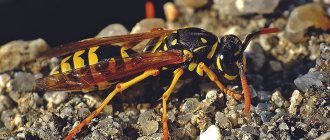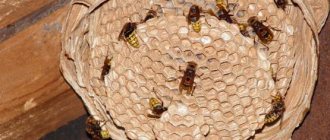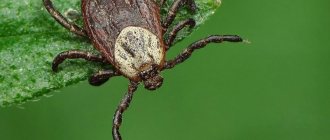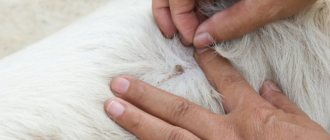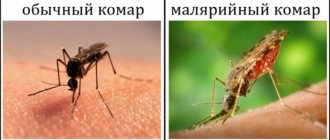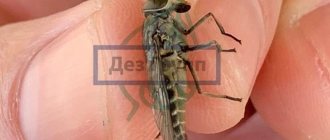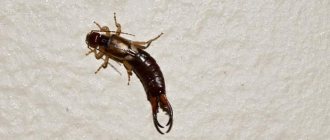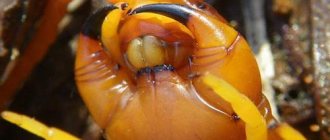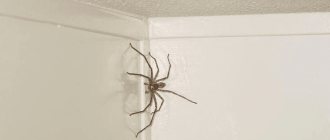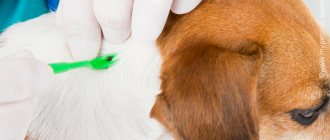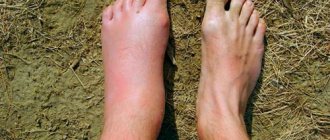Horseflies are the largest blood-sucking insects. They live in the forest-steppe, taiga and forest zones of Russia. The bite of a horsefly, like the attack of other blood-sucking insects, is dangerous, primarily due to the toxic effect of saliva. The insect can cause serious harm to farm animals and humans with hypersensitivity, chronic diseases of the cardiovascular and respiratory systems. It is known that large females are capable of sucking 200 mg of blood
.
A small number of dipteran parasites are not dangerous for people and animals. In most cases, it is enough to treat the wound with ointment to relieve inflammation and speed up healing, and prevent the appearance of scars. Only with individual intolerance and a tendency to allergic reactions may a person require professional medical help.
Completely different consequences are typical for mass attacks of horseflies. The toxic effect of saliva can cause local inflammatory processes and changes in general physiological indicators (blood formula, body temperature). If cattle are regularly attacked by horseflies and other representatives of midges, the animals' productivity indicators decrease over time, the amount of milk and meat decreases, and the quality of wool deteriorates.
A bit of Wikipedia
Photo of a female horsefly
The horsefly is a large blood-sucking insect belonging to the order Diptera. Of the 1,600 known species, about 200 varieties are found in the CIS. If for males the food is plant nectar, then for females it is the blood of humans and animals.
Females have a proboscis with a cutting apparatus. When an insect bites through the skin, a person experiences sharp pain. During a bite, the female injects a substance that prevents blood clotting , so blood flows from the wound for a long time.
Difference between horsefly and gadfly
Externally, the insect looks like a large gray fly, but with large eyes. The size of the body varies from 6 cm to 30 cm. The wings are decorated with a marble-colored mesh pattern. They prefer to fry and do not fly in the cold. Particular activity is observed before rain, but if there is wind, you will not see insects .
Sometimes you can hear that a gadfly has bitten, but this is a mistake, since the horsefly and the gadfly are completely different insects. They even differ in appearance, but the consequences of their bites are approximately the same.
Appearance Features
There are about 1,600 species of horseflies in nature. All of them are large in size - about 2 cm. The female is easy to distinguish by her large build, large iridescent eyes and the bridge between them.
The insect has an extremely complex oral apparatus. Powerful jaws, piercing, cutting, sucking components. Pierces the skin thanks to its fleshy, long proboscis.
The male's abdomen is pointed, the female's is rounded. Coloring in gray, brown dull tones. Large eyes are clearly visible, shimmering in the sun with all the colors of the rainbow.
Horsefly
Why is a horsefly bite dangerous?
The human body’s reaction to a horsefly bite can be different, it all depends on individual characteristics. What does a horsefly bite look like? For some, the bite passes with average sensitivity, for others allergic reactions appear, the bite site swells, lumps and boils form, and sometimes breathing problems occur.
Swelling after a horsefly bite
If no reaction follows after a horsefly bite, a papule will form at the site of the wound, which will go away within two days. But if the matter is not limited to slight redness, then the swelling can completely cover the limb. In this case, there is a pronounced allergic reaction on the face.
Important! If after an insect bite only a small papule appears with slight redness, and the only symptoms are annoying itching, then such a reaction is considered normal. If the swelling has spread throughout the entire limb or any additional sensations arise, you should seek medical help.
Did you know that...
Horseflies are one of the fastest flying insects. They reach speeds of up to forty kilometers per hour ! In this case, the insect makes approximately 125 wing beats per second ! Therefore, it is not so easy to escape from them. Yes and there is no point. It is necessary to take other methods of defense that will scare off these aggressors in advance.
By the way, we included these insects in our TOP 10 most dangerous bites . You can view the full list here: The most dangerous insect bites - TOP 10 in Russia
By
The first symptoms after a horsefly bite
What symptoms may appear after a horsefly bite:
- severe pain and burning in the affected area;
- swelling at the site of the bite;
- Strong headache;
- swelling, including of the entire limb;
- difficult to stop bleeding;
- unbearable itching;
Sometimes dirt or pathogenic bacteria get into the wound , which causes infection and suppuration. To prevent unwanted consequences, it is recommended to use various sprays to protect against midges. With proper treatment of the bite, the swelling disappears in a couple of days.
How a horsefly bites (photo of the mouthparts)
Life cycle and reproduction
The life cycle of a horsefly includes four main stages:
- egg (the female lays from 400 to 1,000 pieces);
- larva;
- chrysalis;
- imago (adult).
The total duration of complete transformation is 4 years.
The method of reproduction of horse flies is similar to that of other dipterans. After mating, the female lays eggs on leaves and stems of plants, in water and moist soil.
The horsefly larva hatches in 3-8 days. This stage lasts about a year. In the spring, the larvae begin to pupate, having first moved to a drier place. This process may take several weeks. As a result, an adult horsefly is born.
Possible complications after a horsefly bite
Sharp, unbearable pain is the least that a horsefly can leave its victim. Sometimes an insect bite leads to much more unpleasant consequences and complications. For example:
- Severe allergic reaction. The person’s condition noticeably worsens, there is severe swelling at the site of the bite, characteristic allergic symptoms appear (shortness of breath, swelling of soft tissues, nausea, vomiting, weakness in the body, etc.) Sometimes symptoms may appear only the next morning. Without proper treatment, the patient's condition will worsen.
- Non-healing wounds, suppuration, and boils form at the bite sites . Secondary infection occurs. To relieve itching, it is necessary to use an antiseptic, healing creams, and cold compresses.
- If the lymph nodes are enlarged , consult a doctor immediately, as in rare cases horsefly can cause the development of dangerous infections.
A strong reaction to a horsefly bite can occur in completely healthy people, but children are most susceptible to an allergic reaction. Hence the risk factors:
- young age (still immature immunity);
- weakened immunity (due to illness, age or after surgery, for example);
- allergies can also develop due to some medications that you have taken before;
- Chronic illnesses also increase your chances of getting a severe allergic reaction;
- alcohol or drug intoxication.
According to statistics, only 0.3% of people who are bitten develop a severe allergic reaction to a horsefly bite - how to relieve swelling in such a situation? To begin with, apply a cold compress, and then proceed based on the state of the body.
What to do if a horsefly bites a child? Children's immune system is still too weak and is not familiar with natural poisons and toxins. Therefore, the reaction of a child’s body to a horsefly bite can be much brighter than that of an adult.
In rare cases, the following symptoms are observed:
- shortness of breath develops;
- heart rhythm is lost;
- blood pressure may decrease;
- Nausea, dizziness and vomiting begin.
Let's take a closer look at the most interesting facts about their life as gadflies.
The female cutaneous or bovine gadfly lays eggs in certain places on the hairline or directly on the skin of large ruminants in places with the thinnest and most delicate skin. Such places are skin folds in the groin or armpit area, on the skin of the udder, and so on. After the larvae hatch from the egg, they pierce the skin with their powerful jaws, while feeding, and thus move under the skin towards the upper surface of the animal's back. By this time, the larvae have time to mature, emerge to the surface of the skin, pupate and fall to the ground.
The gastric gadfly strives to lay its eggs where they will be swallowed by the animal - the edges of the lips, the mirror of the nose. Perhaps this type of gadfly is the most intelligent. Females are able to lay offspring even in areas that are relative, for example, places on the skin where the animal reaches with its teeth to scratch itself, as well as on the grass of pastures. In the latter case, the eggs will simply be swallowed. They will continue their development in the rumen of ruminants, and then in the form of a pupa they will emerge through the esophagus, pharynx and nasal passages.
The human gadfly in the conditions of our continent can only develop in laboratory conditions. In our country, neither the air temperature, nor the length of the daylight period, nor the duration of summer are suitable for him. But in the conditions of Central America he is very comfortable. The attack on people occurs quietly and imperceptibly, the female gadfly lays eggs on the scalp, and the larvae, gnawing through the skin, move closer to the bones of the skull.
In all cases, all types of gadflies cause significant damage to agriculture, especially in the field of dairy production. When the active year of gadflies begins, cows' milk yields decrease by an average of 15%, and weight gain - by 30-35%.
With timely treatment of livestock against gadflies, it is possible to avoid the penetration of larvae under the skin, however, the very presence of these insects greatly irritates the animals, as a result of which productivity is greatly reduced.
Gadflies prefer almost all types of large and small ruminant and whole-hoofed animals - large and small cattle, pigs, horses. However, there are species that preferentially attack only a certain type of animal, for example, the deer botfly.
The cattle senses the string, which is what the female gadfly is called, from a long distance. Apparently because the insect is capable of producing a characteristic buzzing sound. As soon as one cow from the herd hears the line, she emits a warning moo, the animals gather in groups, stop feeding and drinking water, and behave quite belligerently. If there is a pond nearby, the cows will definitely climb into it up to their horns, leaving only their nostrils on the surface to breathe.
Female gadflies are also not born with bast. Knowing how cattle react to them, they can fly up, landing at long distances and in short dashes bring them closer to their target.
Gadflies are characterized by such a phenomenon as a male harem, if one could put it that way. In the area, most often in dry lowlands, groups of males gather, waiting for a female to appear. The lines are like honey, they fly into such harems one by one, mate and fly away to lay eggs.
If you look into the linguistic origin of the word “gadfly,” scientists have not been able to figure out its meaning. The concept of “pout”, widespread in the Siberian outback, refers specifically to the gadfly, but has nothing to do with the blood-sucking horsefly, which is very similar to the gadfly.
Adult insects are no longer dangerous to people and animals. They don't eat. Their life is maintained by the nutrients accumulated in the larval state in the host's body. usually does not exceed one month. During this time, the female must find a partner and mate.
Females try to lay eggs on the hairy part of the human body, which go through several stages:
- The first stage larvae form within 3-5 days, being outside, and then penetrate under the skin. To do this, they secrete a special secretion that helps them easily pass through tissue.
- The larvae in the second stage emerge from the host's back and form holes or fistulas that provide access to oxygen.
- At the third stage, they leave the body and go outside. But before that they cause a lot of problems for the owner.
Once in the human body, the larvae of this species of flies cause severe discomfort and lead to a number of adverse consequences. By releasing a special enzyme into the tissues surrounding them, they feed on the resulting fluid and actively grow.
First aid when bitten by a horsefly
In the summer, especially near rivers, annoying insects often attack. What can be done at home, and how to provide first aid if a horsefly does bite?
Emergency help:
- First of all, do not touch or scratch the wound . Try to keep the bite area clean.
- To reduce burning and pain, it is recommended to apply some cold object or ice .
- To prevent re-infection, wash the wound with clean water and soap .
- If you are not allergic, you need to treat the affected area green or iodine .
- It would be a good idea to use a bactericidal patch .
It is important to know! When planning to relax in the lap of nature, it is worth taking with you a first aid kit, which will include first aid medications. This is cotton wool, a bandage, iodine, hydrogen peroxide, brilliant green, a bactericidal patch, an antihistamine if you are prone to allergic reactions.
Varieties
Currently, over 4 thousand species of horseflies are known. Often the characteristic features and lifestyle of an insect are indicated by its name:
- bullfly (one of the largest dipterous insects),
- deer horsefly,
- gray horsefly,
- ordinary raincoat,
- lacewing,
- forest lacewing, etc.
Gray horsefly
Folk remedies for treating horsefly bites
If you are bitten by a horsefly and your leg swells, what should you do in such a situation, and how to relieve the swelling? To stop the bleeding and reduce the inflammatory process: swelling or hyperemia, it is necessary to use the juice of medicinal plants, which has anti-inflammatory and astringent properties. Such plants include:
- dandelion;
- peppermint;
- plantain;
- aloe juice;
- parsley;
- yarrow.
At home, you can wipe the affected area with lemon juice, garlic or onion.
Briefly about the insect
Before considering the answer to the question of what to do if you are bitten by a horsefly, you need to say a few words about this annoying invertebrate. The parasite belongs to the Diptera family, i.e., simply put, it is a fly.
Individuals can be small (some species), but usually they are large insects from one to three centimeters. A characteristic feature is the presence on the head of large eyes (often with a multi-colored iridescence), two wide wings (cloudy or transparent with a clear network of veins), a piercing-cutting-licking mouthparts and, as a rule, a wide abdomen.
Flies are not brightly colored, most often gray to brown. Examples of the most common types are shown in several photos in this article. This color helps them hide in the grass, where they spend most of the time searching for prey.
In the photo there is a bullfly (female)
Habitats: meadows, green fields, forests and any open areas with grass. Preference is given to wet ecotopes, such as banks or marshy meadows.
These are the most suitable conditions for laying and living of larvae. In the city they can be found sporadically, usually in park areas. At the moment, entomologists have identified more than 400 species of horseflies, 200 of which live in the CIS countries.
Note. Only females bite from warm-blooded animals, because they need blood for the formation and maturation of eggs. Males are harmless and are needed only for fertilization. Their diet consists of plant juices.
When a potential victim is discovered, female insects show persistence, so simply driving them away will not work. They will continue to try to bite until they get their fill of blood or are killed.
Even if they are damaged, for example, by an unsuccessful palm strike, they will still continue to attack. Quite often they attack in the head when a person is in the water.
The bite is always painful because their mandibles penetrate deeply into the skin, but it is not always possible to notice when an insect lands on the skin or hair, because they fly quietly and carefully land on the body. When the parasite pierces the epidermis, it injects saliva containing proteins, anticoagulants and other substances toxic to the human immune system.
This causes a local allergic reaction, which in some people can be quite severe, and in a very small number it can cause a state of shock requiring immediate medical attention.
Important. Horseflies are carriers of plague, anthrax, foot-and-mouth disease, polio and other dangerous diseases.
Traditional Treatments
To relieve an allergic reaction, antihistamines are used:
- "Claritin";
- "Diazolin";
- "Allergozan";
- "Suprastin";
- for children - “Cytirizine”.
To eliminate itching, a solution of baking soda, mint-flavored toothpaste, and ammonia will help. Also, the affected area can be lubricated with “Hydrocortisone ointment”, “Advantan” . The Golden Star balm helps a lot, although it gives some people headaches.
Habitat
Horse flies and horseflies live in forests. Habitats range from deserts to alpine meadows. Found at an altitude of 3300 m from sea level. Usually found near cattle, stables, ponds, swimming pools, and forests. lawns. They feed during the day and are most noticeable on windless, hot, sunny days. The larvae develop in moist soil near water bodies.
They are found throughout the world, except in the polar regions. Absent on some islands such as Greenland, Iceland, Hawaii.
All genera Tabanus, Chrysops, Haematopota are found in temperate, subtropical, and tropical regions. Haematopota is absent from Australia and South America.
How to protect yourself from horsefly bites
To protect yourself from horsefly bites, it is recommended to use personal protective equipment and know the habits of this insect.
- Horseflies prefer to attack during the day in good weather.
- When planning an outdoor recreation, clothes should be with long sleeves , shorts should be excluded, only jeans or sweatpants.
- To protect the stroller, you can use a special insect net.
- If you grind mint, wormwood or lemon balm and apply the juice to the skin, this will help drive away not only horseflies, but also bees, wasps and bumblebees.
In the end, let’s repeat the common truth: no bite, no problem ! Therefore, it is better to take measures to prevent the insect from biting you. If for some reason the horsefly still bites, do not panic. The bite site should be washed with clean water and treated with an antiseptic. To relieve swelling, use special ointments. If an allergic reaction develops, feel free to call an ambulance.
Post Views: 506
Prevention
In nature, you need to carefully monitor children, because they are often attacked by insects
You can protect yourself from annoying insects using repellents applied to the skin. When outdoors, it is recommended to cover exposed areas of the body with clothing. You should not sleep on the grass or in the forest; mosquito nets should be installed on windows and doors.
It is important to remember that it is quite difficult to avoid horsefly bites, but if you are careful, you can prevent this. The surest way to attack an insect is to try to kill it.
What diseases are carried
Horseflies are known carriers of several bacterial, viral infections, protozoa and worms. For example, equine infectious anemia virus, various types of trypanosomes that cause diseases in animals and humans.
Find out more The largest insects on Earth
Chrysops species transmit the filarial worm Loa loa between humans, anthrax among cattle and sheep, and tularemia between rabbits and humans.
Blood loss is a common problem in animals when there are many large animals. Some animals are known to lose up to 300 ml of blood in a single day, a loss that can weaken or even kill.
There are reports of horsefly bites causing fatal anaphylaxis in humans, which is extremely rare.
